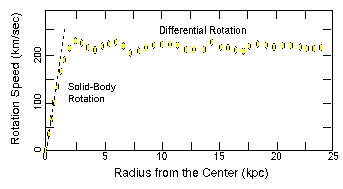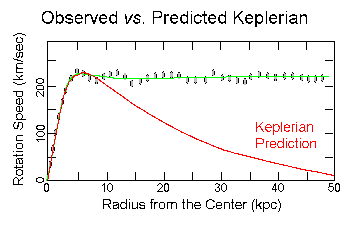

|
Astronomy 162:
Introduction to Stars, Galaxies, & the Universe
Prof. Richard Pogge, MTWThF 9:30
|
Lecture 41: Dark Matter & Dark Energy
Readings: Ch 26, sec 26-8; Ch 28, sec 28-6 & 28-7
- Dark Matter
- Matter we cannot see directly
- Detected only by its gravity
- Most of the matter in the Universe?
- Dark Energy
- Vacuum energy of the Universe
- Responsible for the acceleration of the Universe's expansion
Galaxy Rotation Curves Revisited
Spiral Galaxies rotate such that the rotation speed:
- Rises steadily from the center to the inner disk
- Becomes roughly constant (flat) with radius in the outer parts
as far as can be measured in the disk.

Recall from our discussion of Spiral
Galaxies that the total mass inside of a particular radius within a
galaxy is approximately

Mass Distribution in Galaxies
Most of the stars in a typical spiral galaxy are in the inner 10 kpc or
so.
If stars provided all of its mass we would expect the following:
- The rotation speed should rise to a maximum speed in the inner parts
- The rotation speed would then fall steadily with radius outside
a radius of ~10 kpc (i.e., Keplerian), since most of the mass in stars
is inside of our orbit beyond that distance.

But, the observations show that the rotation speed stays roughly
constant (a "flat rotation curve") at large radii!
- Higher speeds at large radii mean you need to have more mass
at large radii than is observed in the stars and gas alone...
What is going on?
Dark Matter Halos
- Question:
- What is the source of the extra mass if it is not stars & gas?
- Answer:
- Galaxies must have extended dark halos.
Properties of Galaxy Dark Halos:
- Contains ~90% of the galaxy's mass
- more extended than the starlight component
- The orbits of satellite galaxies suggest that dark halos may
extend out as far as 200 kpc!
Dark Matter in Galaxy Clusters
In 1933, Caltech astronomer Fritz Zwicky measured the motions of
galaxies in the Coma cluster
- He found velocities of +/-1000 km/sec relative to the cluster center.
- This is greater than the escape velocity computed by adding up all of
the stars in the cluster galaxies.
This led Zwicky to suggest that there must be a component of "dark
matter" that adds extra gravity to hold the cluster together.
Subsequent observations have demonstrated that galaxy clusters are 90-99%
dark matter.
- Clusters are filled with hot X-ray emitting intergalactic
gas. Without dark matter, this gas would dissipate quickly.
- Gravitational lensing of background galaxies by clusters is so
strong that it requires a signficant dark matter component.
Together with galaxy rotation curves, this tells us that what we see
(stars and gas) is not the whole picture.
Dark Matter
We call this mysterious extra matter Dark Matter because it
cannot be detected directly using light of any kind.
Dark Matter can be detected astronomically only by its gravitational
effects on stars and gas:
- It makes the outer parts of galaxies rotate faster than expected
from their starlight.
- It makes galaxies in clusters orbit faster than expected from
the total starlight of the galaxies.
- Confines the hot X-ray gas that would otherwise evaporate from a
galaxy cluster.
But, what is the Dark Matter made of?
Baryonic Dark Matter
Baryons are ordinary matter made of protons & neutrons.
Candidates:
- Brown Dwarfs and Jupiter-sized planets.
- Cold stellar remnants (black holes, neutron stars, and white
dwarfs)
- Primordial black holes (leftover from the Big Bang)
- Frozen hydrogen snowballs
All such forms of baryonic dark matter are collectively called
- Massive Compact Halo Objects (MACHOs)
Microlensing Searches
If a MACHO passes between the Earth & a more distant
background star:
- GR predicts that the MACHO's gravity will bend the starlight
of the more distant star around it.
- This makes a "Gravitational Microlens" that briefly
magnifies the background star.
Such chance alignments are very rare:
- Most should last only for a few weeks.
- Must monitor millions of stars for many years to catch these events
in action.
A number of projects have undertaken multi-year monitoring of the
LMC and SMC hoping to catch lensing by MACHOs in the Galactic Halo:
- Watched ~12 Million stars for ~6 years.
- Found only about 13-17 halo microlensing events
- Most likely mass range is 0.15-0.9 Msun
(Jupiters or white dwarfs?)
While interesting, the best limits to date are that MACHOs
an only make up ~20% of the mass of the halo of our Galaxy.
Non-Baryonic Dark Matter
These are fundamental particles that only interact via gravitation and
the weak nuclear force.
Candidate Dark Matter particles include:
Massive neutrinos:
- Produced in large numbers in the Big Bang??
Exotic new particles:
- Predicted by some theoretical particle physics models.
These are often collectively called Weakly Interactive Massive
Particles, or WIMPs for short.
Particle Dark Matter Searches
Attempts to directly detect of dark matter particles.
These include:
- Estimates of the masses of neutrinos (very tiny)
- Particle accelerator experiments searching for new massive
particles in collisions, as predicted by some particle models.
- Searches for "cold dark matter" particles hitting
the Earth from space.
So far, no convincing detections have been reported, but the searches
go on.
Dark Energy
As we saw in the lecture on Fate of the
Universe, galaxy distances measured using Type Ia Supernovae as standard candles suggest
that we live in Universe that is
- Infinite,
- Spatially Flat (W0=1),
- Accelerating (WL >
Wm)
The extra expansion is due to something generically called Dark Energy
- Extra energy filling the Universe
- Acts to inflate the universe against gravity
What is Dark Energy?
We know even less about Dark Energy than we do about Dark Matter.
Some forms of Dark Energy that are being discussed currently:
Cosmological Constant (L)
- Vacuum energy component whose density is constant over cosmic history
- Akin to Einstein's Cosmological Constant, but motivated by quantum
Mechanics, not by a (mistaken) desire to stabilize the Universe against
expansion or contraction.
Generic Dark Energy
- Vacuum energy component whose density can change over cosmic history
- Candidates include scalar fields, quintessence, and stranger ideas.
Future studies may (or may not) help resolve the question of the
behavior of Dark Energy, which would provide us with clues as to its
origins.
The Contents of the Universe
Whatever Dark Matter and Dark Energy are, we can at least for the
present estimate their contributions to the total density of matter
and energy of the Universe, W0:
- Baryonic Matter: Wb
- Stars: 0.4%
- Gas: 3.6% (most of it very hot gas)
- Based on assays of galaxies, clusters, and intergalactic gas.
- Dark Matter: Wdm
- Dark Matter: 26%
- Based on Galaxy Rotation Curves & Galaxy Cluster dynamics
- Dark Energy: WL
- Vacuum Energy: 70%
- Based on acceleration of the Universe from Type Ia Supernova measurements
- Total: W0 =
Wb + WdmWL
- W0 = 1.0
All of these, of course, are subject to change as better data are acquired.
A (Very) Radical Suggestion:
Maybe Dark Matter and Dark Energy don't exist at all!
Is our theory of gravity wrong on large scales?
Problems:
- None of the alternative theories of gravity have survived
key tests of their detailed predictions.
- Some alternative theories don't even make reasonably testable predictions.
- Hard to reconcile these theories with the observed gravitational
lensing.
While still a possiblity that a few astronomers are exploring actively,
so far this line of inquiry has been less fruitful than others.
Return to [
Unit 6 Index
|
Astronomy 162 Main Page
]
Updated: 2006 March 5
Copyright © Richard W. Pogge, All Rights Reserved.




